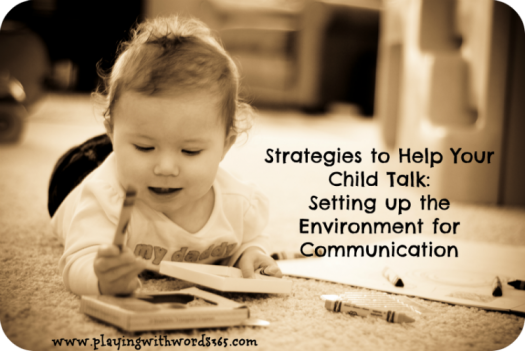In my LAST POST about Strategies to Help Your child Talk, I talked about modeling and how you need to require that your child use language. However, when I say “language” here, I am not only referring to using words. The “language” you are requiring could be the use of gestures, signs, pictures, etc…anything that is getting your child to communicate to you. And how do you do this? The best way is to set up the environment for communication by embedding communication temptations into your child’s day.

What is a communication temptation? A communication temptation is an activity or situation that is set up to “tempt” your child to use language.
 How do you use a communication temptation to get your child to talk? You want to first set up the communication temptation. Then during the activity, you will want to model the language you want the child to use. This is important. You need to model so the child can use your model to learn how to communicate. Your model should be just slightly beyond, or slightly more advanced, than what they are already doing on their own. So, if they are not speaking at all, you may model signs, words, or possibly using a picture to request an item (this all depends on the individual child). If they are using only single words, you will want to try to model two word utterances. Then when they attempt your model, reward them with the item.
How do you use a communication temptation to get your child to talk? You want to first set up the communication temptation. Then during the activity, you will want to model the language you want the child to use. This is important. You need to model so the child can use your model to learn how to communicate. Your model should be just slightly beyond, or slightly more advanced, than what they are already doing on their own. So, if they are not speaking at all, you may model signs, words, or possibly using a picture to request an item (this all depends on the individual child). If they are using only single words, you will want to try to model two word utterances. Then when they attempt your model, reward them with the item.
What are examples of communication temptations? There are so many different ways to set up your child’s day to “tempt” them to use their language. Here are some suggestions of communication temptations you can use to help get your child to communicate (adapted from Wetherby & Prizant, 1989).
During Play:
- Take a toy that your child enjoys playing with, and remove the batteries. Wait for your child to realize it is not working and model for him/her the language you want him to use. For example, you can model the sign or word “broken” or “help”. When he does so, put the batteries in and give him the toy. Repeat with other toys.
- Take a toy that your child REALLY loves and start playing with it, not allowing your child to play. When he is starting to indicate he wants a turn, model the language you want him to use, like “Car Please” or the sign for car, or giving you a picture of a car in exchange for the car. Once he attempts requesting for the item, give it to him immediately.
- Give your child only some parts of an activity or toy, but not all the parts (like only 1/2 of a puzzle, or only 3 train tracks). When the child begins to indicate that he realizes pieces are missing, model the language you want him to use. For example, “Track please” and then hand him another track piece. Then require him to request again to get more tracks. I do this ALL THE TIME in my sessions with children. My Thomas the Train set is one of my MOST USED therapy items!
- In relation to the example above, during an activity try giving you child an item that does not fit (like a puzzle piece that doesn’t fit, or a piece of train track that won’t work, for example). Model the language you want him to use “Uh oh! Doesn’t work! Need another!” etc.

- While playing with your child, randomly take away some of his toys and wait for him to indicate he wants them back, and then model the language you want him to use.
- Engage your child is a fun social game like tickles, peek a boo, or swinging on the swings. After playing for a short while, pause to give your child an opportnuity to request more of the activity. Model the language you want the child to use (for example, rather than allowing “more” I would model the actual verb like “tickle” “swing” or “peek”).
- Activate a wind up toy, let it do its thing, and then when it’s done wait for your child to indicate that he would like the toy to be wound up again. Model the language you want him to use.
- Get out bubbles, blow a bubble, then put the lid back on and hand it to the child. Wait for the child to indicate that he needs/wants help. Model the language you want him to use.
During Mealtimes/Snack times:
- Grab a food that you KNOW your child loves, and eat it in front of him/her without offering her any. Wait for your child to indicate that they want some, and then model for them how to appropriately request an item. This could be modeling using a sign, gesture, or a word (depending on how your child is communicating at this time). When he attempts to request in a more appropriate manner, give him the food item.
- During meals or snacks, rather than giving your child all his food at once, only provide him with a couple bites of each item. When he is indicating he wants more, model the way you want him to request. For example, you could model the sign “cracker” while saying “cracker please” and so on. I suggest NOT using the word “more” to request for more, but rather the name of the item.
- Give the child a food you know your child does NOT LIKE. Model the language you want him to use like “no” or “no thank you”.
In the environment/routines:

- Take some of your child’s toys (that he REALLY likes), and place them in CLEAR bins in a place that is visible for the child but not accessible. Your child will have to request the items from you. Model the language you want your child to use (i.e. the sign or word for the item like “trains” or “trains please” or “I want trains please”).
- Don’t allow your child free access to things like food, the computer, TV, iPad, CD player, etc. Put them away (but visible, when possible) so that your child needs to request to use them. Only allow limited use, then put away so they will need to request to use the item again.
- Change up your routine. For example, “forget” to brush your child’s teeth or “forget” to give your child a bath. Model the language you want the child to use “Uh oh! Forgot bath! Need bath! Brush teeth!” etc. (Other ideas: place the child in a different seat at meal times, drive home a different way from the store, try serving dinner foods for breakfast, etc).
- Provide obstacles: For example, tell the child you are going to go outside…after you have put a chair in front of the door, or locked the door. Model the language you want your child to use “Uh oh! There is a chair in the way! Chair! Move!” etc.
Ok, so I tried some of these and they didn’t seem to work. My child just walked away! What went wrong? This is important: for these strategies to work, the child needs to actually WANT the thing you are “tempting” him with. So, if you give the child a puzzle, for example, with only a couple parts and he just walks away, the toy simply isn’t motivating enough at that time. Try something else. Some children are more challenging than others to get to use their language. I find food works REALLY WELL. Also, another tip: to make toys more motivating (to make your child WANT that toy) put it away for a while (like at least a week) where the child cannot see it or play with it. Then try again. A child will be way more motivated to get a toy if they do not have free access to it all day, every day.
A quick note about the word/sign “more”: I mentioned earlier that I do not typically recommend using the sign or word “more” when teaching your child language. Rather, you should try to teach them the word/sign for the item they are actually wanting more of (like cracker, milk, apple, puzzle, etc). It is very wasy for a child to simply use “more” to indicate he wants more of something, but them he is not getting the opportunity then to say/learn the actual name of the object. So, using “more” can actually limit your child’s vocabulary while you are trying to do just the opposite. So whenever possible, model the sign/word for the item and NOT the concept of “more”. Once your child knows and uses the name of the object to request, you can add “more” to his/her utterance: more milk, more crackers, etc.
What other strategies can I use to help my child’s language development? Check out these posts in my Strategies Series:
Using Expansions and Extensions
Commenting and Asking Questions
Setting up The Environment for Communication
I hope you find some of these ideas useful! Please feel free to comment or email me with questions!
Cheers!
Please remember that this information is for educational purposes only. If you feel your child has delays in his/her communication skills, please speak to your pediatrician or locate a speech pathologist in your area for an assessment. Be sure to read the full TERMS OF USE on this site for more info. For tips on how to find an SLP in your area. read HERE.
Love the suggestion to teach them the nouns for things they want, and adding more afterwards. I taught both my sons the sign for “more” when they were babies, but I think I will try your suggestion with my daughter. (Although you might not have been referring to infant sign language… and maybe you don’t actually recommend that?! :o) )
Laurie, ssshhhh don’t tell but I taught my daughter the sign for “more” when she was a baby 😉 She used that sign FOREVER without saying the word “more” it was actually pretty cute. With my son, I planned on using the word “eat” rather than “more” but I have been slacking on his baby sign. He does sign “milk” tho!!
For the record, I am a HUGE advocate of baby sign!! I did a research paper on it in grad school and I was sold. My daughter used many signs and like I said, I have been kinda slacking with my son (poor second child) but he also spoke his first word at 9 1/2 months (early). 🙂
If I withhold something she wants (milk, for example), when should I relent and give her the item she wants? She’s 20mo and isnt’ talking yet (we just started seeing a speech therapist regularly). If she doesn’t make the sound “mmmm” for milk, when do I relent and give it to her? She gets VERY frustrated when I withhold the item and I don’t know how far to push it.
Hi trish. The best thing I can recommend is to ask your SLP. You have to be very careful with this technique at first, especially if the child is having a hard time producing and putting together the speech sounds. It is very careful give-and-take relationship and we want to build success while not frustrating her too much…which is why I recommend asking the professional that is working with her. I wish I could give more advice but it is hard whiteout working with the individual child. Good luck to you! 🙂
Hi, I really enjoyed all of these articles on encouraging language skills. My baby has just turned one and hasn’t really started talking yet although I am guilty of teaching her the word ‘more’ apart from dad this is her only word. Should I try inrroducing baby sign language (she knows milk already) or start ‘tempting’ her with spoken words. Mostly she uses the word more for a balloon game we play.
Thanks again for these articles.
🙂
Misha at just one year (12 months), I would just continue to talk to her, PLAY with her, and follow her interests. No need yet to worry about her as many 12 month olds will only have a couple words. Good luck!
Hi Katie,
I am also an SLP and i love your blogs.its like a refresher course for me.:)I have a 1yr old and 3yr old and my 3yr old is a quiet man. I use all the known strategies with him but let’s just say e is not that much into toys. He loves to play with real electrical stuff( vacuum cleaner,grinder,etc). I have tried to tempt him into using words more often(such as when needing to turn on the tap, I wait for him to say please turn on tap) but he knows how it works and so he manages to do his things independently( a good problem solver). Any suggestions on how to make him respond to our interactions?sometimes the parent in me gets the better of the SLP !
it seems to me that this method is designed for either very young children or children with autism. I wonder if it was ever intended to treat a 6 year old with selective mutism. My therapist has me offering my child a choice between two things, usually treats or snacks. If she tells me what she wants she gets her choice. If she tries to respond non-verbally, I get to choose. We have been doing this in the parking garage behind her school because there is some foot traffic but not much so it’s meant to be semi-public. She gets to choose between two snacks, one really cool and one not so great. So far we have been doing this for a couple of weeks and she just gets really sad and walks away in tears. Am I wrong to think that maybe this method is not intended for SM? She has social anxiety and if it were as easy as giving her the right incentive she wold have been talking in public long ago because I have offered her some pretty great things in the past. What do you think?
Hi Veronica. These methods are for a variety of children with language delays, however selective mutism is a totally different ballgame and needs a different set of approaches. I am not experienced with SM so I cannot really provide recommendations, but I would recommend getting therapy from professionals well versed in SM, which may or may not be an SLP. Good luck to you!
HI,
Loved the blog! I have a little boy who just turned 4 last and he is delayed in speech and is in early intervention. He is definitely communicating his needs but we have a hard time expanding his sentences and answering questions. Do you have any tips on helping us do this?
I forgot to add he is a very audio/visual learner.
I love this site and all your very practical suggestions for parents. Many of these are strategies are ones that I have shared with families that I support. These strategies work! Thanks for sharing these on the net. This is a great resource for families 🙂
I was able to read your article and found this information to be very practical for the type of work that I do. I am a Developmental Therapist for Early Intervention. And I work with Speech therapists on a daily basis. They all have wonderful ideas and strategies for communication. I would like to know, since it is advised not to used the “more” sign because it is limiting the child’s ability to learn more words, which I can agree, what suggestions do you have for non typically developing language amongst autistic children.